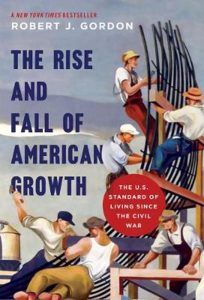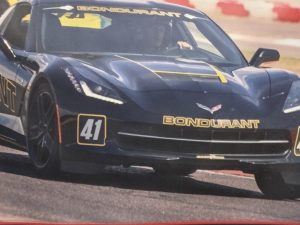by Richard Passov
Robert Gordon is the Stanley G. Harris Professor of Social Sciences at Northwestern University. In a well-received book, The Rise and Fall of American Growth, Gordon ‘…contributes to resolving one of the most fundamental questions about American economic history’ by providing ‘… a comprehensive and unified explanation of why productivity growth was so fast between 1920 and 1970 and so slow thereafter.’
 The ability to control electricity so that it arrives in measured doses where and when needed combined with simple steps to improve public sanitation, such as running water, indoor toilets and the removal of the uncountable tons of horse manure that marked major cities before the advent of the internal combustion engine that spurred roads and transportation networks that enabled frozen food to be enjoyed from coast to coast, wrought a step change in living standards unlikely to be repeated.
The ability to control electricity so that it arrives in measured doses where and when needed combined with simple steps to improve public sanitation, such as running water, indoor toilets and the removal of the uncountable tons of horse manure that marked major cities before the advent of the internal combustion engine that spurred roads and transportation networks that enabled frozen food to be enjoyed from coast to coast, wrought a step change in living standards unlikely to be repeated.
Economists know the growth in Gross Domestic Product (GDP) in any period. And total hours worked and the change in capital. They apportion contributions from labor and capital to GDP based on the amounts of income they ascribe to labor and capital. What remains – the residual that’s necessary to arrive at the total growth in GDP – is Total Factor Productivity (TFP). You can think of this as conflating, in the measured period, smarter workers working harder with more and better capital. Or as one equation with three unknowns.
Going into WWII, TFP was elevated: jobs were scarce and to remain in business, an enterprise had to be extremely productive. During WWII, as Gordon points out, Government built an enormous amount of plant and equipment that was retooled to meet the pent-up demands of a population starved for consumer goods. So no great surprise that the US continued to benefit from surging TFP post WWII.

Since 1970, according to Gordon, TFP has been missing. I know where some of it can be found.
* * *
Recently, I spent a few hot days in Phoenix Arizona at the Bondurant School of driving.
On our first morning, three instructors perched on a table at the front of the class. Will was the lead. For the next few days I’d hear his flat delivery coordinating track time over the radio. Tyler, boyish and rail-thin, was assigned to Camaro drivers. The third instructor approached my group. “Well,” he said, “you guys must be here for the Corvette class. I’ll be working with you. “
Also rail-thin with unruly, corn-yellow hair, Chris was from a place outside of Grand Junction that, he said, none of us had ever heard of. We followed to a car with four small tires each extending from the larger car tire, like training wheels. A pneumatic pump in the trunk allowed Chris to shift the car’s center of mass. The point of the exercise is to hold tight to a circle at 40 mph while the instructor changes the pitch of the car.
Lifting the back end simulates the effect of skidding through a tight corner. Stopping the skid requires moving the center of mass toward the rear. Counter intuitively, that requires acceleration. Too much and the car drives through the circle. Not enough and the backend comes abreast of the front-end, putting the car into a spin. Fun and frustrating.
Next, high-speed braking: Get to a good speed then, while avoiding cones, engage the anti-lock brakes. A rare Phoenix-summer downpour inspired Chris to offer advice. “Stay behind 60,” he said. “Passed 60 you’ll hit your breaks and just keep going and notice there’s a wall not too far away.”
The track surface was built back when cars at the school topped out at 300 horsepower. “Back then, you’d get a Mustang up to about say 40, 45 hit the brakes and be fine,” Chris added. “These new ‘Vettes, well you can be goin’ a lot faster than that.”
General Motors describes their ‘Vetts as follows: “Third Generation Magnetic Selective Ride Control, a 7-speed transmission with Active Rev Matching and 5 distinct driver modes ready for any road. With 460 horsepower, 465 lb-ft of torque, 1.03g of cornering and a sophisticated LT1 engine that propels [the] Stingray from 0 to 60 in 3.8 seconds [sp]. It’s the quickest, most powerful, most capable Standard Corvette ever made.”
The emphasis on Standard is to make sure we understand this means a production car, made ready for street driving.
* * *
Rushing to high school in the first car I owned, I felt the backend swing wide. I was in a ‘70 Pontiac Le Mans, already an antique. Its six-cylinder engine, rated at 165 horsepower, connected to a three-speed shifter that came up between bucket seats, straight from the drive train hump. On top of the shifter the previous owner had secured a brass knuckle.
In a moment of classic over-steer, I jammed the brakes. The back-end became the front-end. Watching mailboxes go by, instinct suggested turning the front wheels into the slide. The car straightened out. Fortunately, that street was wide.
* * *
The second day of racing school started with a timed run through a course of three close turns and two short straight sections. One after another we slid through the cones and off the course.
After lunch we were on the main track facing a longer course. After taking the same line through each turn, confidence high, I pulled into the pits. “I’m getting it,” I told Chris, “but in the far turn, there’s a lag. She hangs back.”
“Well,” Chris said, smiling just a little, “… you’re taken’ the turn wrong. Traction control’s kickin’ in. Otherwise, you’d fly right off the track.”
The last clinic focused on heel-toe shifting: Drive toward cones at speed, get to third gear and then do three things with two feet.
Proper downshifting demands avoiding the lurch from a miss-match between clutch plate and engine revolutions. Matching revolutions entails sliding the heel of your braking foot on to the gas pedal and, while keeping the clutch pedal on the floorboard, pressing hard on the brakes while pulsing the engine by giving the gas pedal a quick heel kick.
We all struggled. “Well,” Chris said, “it’s hard.”
“Fortunately,” he went on, “you don’t have to do it anymore. There’s a paddle either side of the steering wheel. Pop that once and you’re in automatic-rev-matching-mode.”
Will, standing near me, leaned in, “Yeah, it’s ol’ school but Mr. Bondurant insists we teach it. A lost art form, I guess.”
* * *
During the early ‘60’s Carl Shelby put Bob Bondurant in a Shelby Cobra and sent him to Europe to beat Ferraris. Like the wine tasting where California Cabs bested old growth Boudreaux, the racing establishment was shocked. Ferrari hired Bob, giving an American a rare shot at formula one. Back in the US, racing at Watkins Glen, Bob experienced a spectacular ‘mechanical failure.’ His career over, he defied the prognosis about never walking again and built a driving school.
Back in the 60’s, good heel-toe mechanics were important. Car technology amounted to large intake valves, multi-barrel carburetors and three important cables – for the brakes, the gas and the clutch. Every part of this milieu has been made over such that today’s clutch is a collection of sensors designed to ensure that no matter how inept the driver is, the actual shift between gears is flawless.
I raced that Le Mans down a valley road but each time I gained a fuller respect for how difficult it is to control a car. After the experience of losing control, I settled into driving from point A to point B.
We still drive from point A to point B. And that’s where Gordon can find some of the missing TFP; it’s trying to stop an over-horsepowered car, on its way to a Starbucks, from flying off the road.
* * *
Gordon offers the following thought experiment: If you have to make the choice, would you choose post 2002 innovations – Facebook, Twitter, the iPad, say – or a pre-2002 world that includes Windows 98, along with indoor toilets. In setting the choice up in this way, Gordon easily demonstrates that we’d trade much of the digital revolution for one simple innovation from the late 19th century.
It’s what the innovation improves upon, Gordon suggests, that determines the worth; much of what we’re inventing now helps us do the same things with less effort and time but not in ways that fundamentally change lives.
Despite a few periods of disruption – the Great Depression and the Financial Crises – Gordon’s graphs slope upward through 100 years of economic history leading to a warning against a ‘past is prologue’ summation. According to Gordon, increasing living standards are not always what the future brings. It’s just seemed this way for a relatively long period of time.
* * *
Some clever economists*, while observing similar symptoms, in particular stagnate growth and increasing income inequality, see things differently. They document a rise in market power, measured as the steady increase in gross margin across industry from an average of 1.18 as of 1980 (meaning the final selling price for goods and services averages 18% above cost) to approximately 1.67 as of 2014.
Contributing to this rise is the increasing prominence of the ‘network economy’ where the marginal cost of production approaches zero and winners tend to be dominant (Google, Facebook, Apple…)
Increasing market power leads to fewer enterprises which in turn decreases demand for, as well as income attributable to, labor and capital. This leads these authors to conclude, somewhat paradoxically, that while work-force participation and wage growth are stagnating productivity is actually rising.
Perhaps these potentially competing observations are in fact complimentary: much of recent innovation is less life-enhancing than the discovery of a method to make penicillin in bulk. And, when it was acquired by Facebook for $19.3 billion in cash and stock, though WhatsApp had over 400 million users, it had less than 60 employees; a feat of incredible productivity resulting in an unprecedented redistribution of wealth.
Whether complementary or not, neither observation calls for closing boarders, starting trade wars and relaxing regulation.
* Jan De Loecker, Jan Eeckhout: The Rise of Market Power and the Macroeconomic Implications, NBER Working Paper Series
